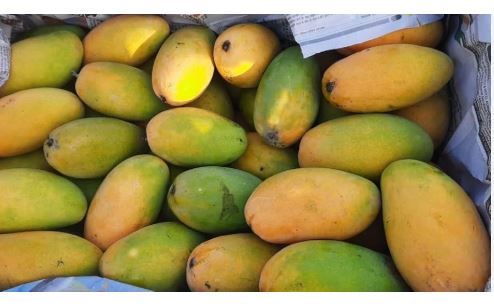
Dasheri mangoes are classified as Mangifera indica, a species within the Anacardiaceae family, which includes cashews, pistachios, and sumacs. The genus Mangifera comprises around 35-40 species of tropical fruiting trees, with M. indica being the most widely cultivated, encompassing hundreds of cultivars globally. Dasheri (also spelled Dashehari or Dushehri) is a monoembryonic variety, meaning its seed produces a single shoot, distinguishing it from polyembryonic types prevalent in Southeast Asia. Originating as a cultivated selection in India, it reflects the rich diversity of mango breeding within this species.
Dasheri mangoes trace their origins to the 18th century in the village of Dasheri, near Lucknow in Uttar Pradesh, India, within the famed Malihabad mango belt. Legend attributes its discovery to a seedling planted in the orchard of Nawab Mohammad Khan Saab, a local noble under Mughal rule, though exact records are scarce. By the 19th century, it had spread across northern India, becoming a prized variety for its flavor and texture. Its fame grew during British colonial times, with grafts distributed to other mango-growing regions like Maharashtra and Andhra Pradesh. Today, Dasheri dominates Uttar Pradesh’s mango production—often called the “King of Mangoes” alongside Alphonso—and is cultivated in Pakistan, Nepal, and parts of the Middle East and U.S. (e.g., Florida), prized for its heritage and taste.
Dasheri mangoes are medium-sized, typically weighing 8-12 ounces (250-350 grams), with an elongated, slightly curved shape and a pointed tip. Their skin is thin, smooth, and transitions from green to a golden-yellow when ripe, often with a faint pink or red blush near the stem. The flesh is a vibrant orange, succulent, and notably fiber-free, encasing a single, flat, monoembryonic seed that’s smaller than many cultivars, maximizing edible yield. Ripening from June to July in India, it’s a mid-season variety with a strong, sweet aroma. The taste is intensely sweet and rich, with a creamy texture and subtle hints of citrus and honey, lacking the tartness of some mangoes, making it a dessert-like treat.
Mangifera indica ‘Dasheri’ thrives in USDA zones 10-11, where frost-free, tropical to subtropical conditions prevail, with temperatures ideally between 70-95°F (21-35°C). It can tolerate brief dips to 30°F (-1°C), but prolonged cold below this damages or kills the tree, limiting its U.S. cultivation to southern Florida, coastal California, Hawaii, and Puerto Rico. In zones 9b-10, it can be grown with protection (e.g., greenhouses or frost cloths) if started indoors and shielded from winter chill, though fruit quality may suffer. It requires full sun (6-8 hours daily) and well-drained, sandy loam soil (pH 5.5-7.5), excelling in humid regions with 30-100 inches of annual rainfall or irrigation.
Culinary Applications
- Fresh Eating: Their sweet, fiber-free flesh and creamy texture make them a luxurious treat for peeling and eating raw.
- Smoothies: Blended with milk or yogurt, they create rich, aromatic drinks with a honey-citrus flavor.
- Salads: Diced or sliced, they add a juicy, sweet boost to fruit salads, pairing well with berries or mint.
- Desserts: Pureed for ice creams, kulfi, or puddings, their intense sweetness enhances tropical sweets effortlessly.
- Juicing: Squeezed into juice or lassi, they yield a thick, fragrant beverage, perfect alone or with spices like cardamom.
- Chutneys: Cooked with green mangoes, chili, and sugar, they make a tangy-sweet condiment for Indian dishes.
- Salsas: Chopped with onion and lime, they create a vibrant salsa, balancing spice with sweetness for grilled fish.
- Preserves: Simmered into jams or aamras (pulp), their rich flavor shines as a spread or dessert topping.
Cultivation of Dasheri Mangoes
- Climate: Dasheri thrives in tropical to subtropical climates with warm temperatures (70-95°F/21-35°C) and high humidity. It requires frost-free conditions to ensure healthy growth and fruit production.
- USDA Zones: Best suited to USDA zones 10-11, where temperatures stay above 30°F (-1°C). In zone 9b, it can be grown with frost protection (e.g., greenhouses or cloths), but cold reduces fruiting reliability.
- Soil: Needs well-drained, sandy loam soil with a pH of 5.5-7.5, enriched with organic matter like compost or manure. It tolerates moderate soils but suffers in waterlogged conditions, harming its shallow roots.
- Sunlight: Demands full sun (6-8 hours daily) for vigorous growth, flowering, and optimal fruit flavor and size. Shade limits yield and sweetness, a key trait of this variety.
- Planting: Propagated via grafting onto rootstocks like Gomera-1 or local seedlings for vigor and true-to-type fruit (seeds don’t breed true). Space trees 25-35 feet apart, planted in spring after frost risk passes.
- Watering: Requires consistent moisture—1-2 inches weekly—during establishment, pre-flowering (late winter), and fruit growth (spring-early summer). Reduce water post-harvest to encourage dormancy; overwatering risks root rot.
- Support: Young trees may need staking for 1-2 years against wind due to shallow roots and brittle branches. Mature trees (20-40 feet tall) benefit from pruning to maintain shape and ease harvesting.
- Pollination: Monoecious flowers (male and hermaphrodite) bloom in late winter to early spring, self-pollinating but improved by cross-pollination via bees or flies. Nearby mangoes (e.g., Chausa) or hand-pollination enhance fruit set.
- Pests: Susceptible to mango hoppers, fruit flies, and mealybugs. Use neem oil, pheromone traps, or fruit bags; sanitation (removing fallen fruit) and predators like wasps help control infestations.
- Diseases: Prone to anthracnose, powdery mildew, and mango malformation. Apply copper fungicides pre-bloom, prune for airflow, and avoid overhead watering—Dasheri has moderate disease resistance.
- Harvest: Fruits ripen mid-season (June-July in India), picked when yellow with a slight give and strong aroma. Harvest with clippers, leaving a short stem; mature trees yield 50-150 lbs annually, depending on care.
- Yield: Begins fruiting 3-5 years after grafting, peaking at 7-15 years with 100-250 mangoes per tree under optimal conditions. Prune lightly post-harvest to remove dead wood and promote next season’s flowering; lifespan can reach 50-100 years.